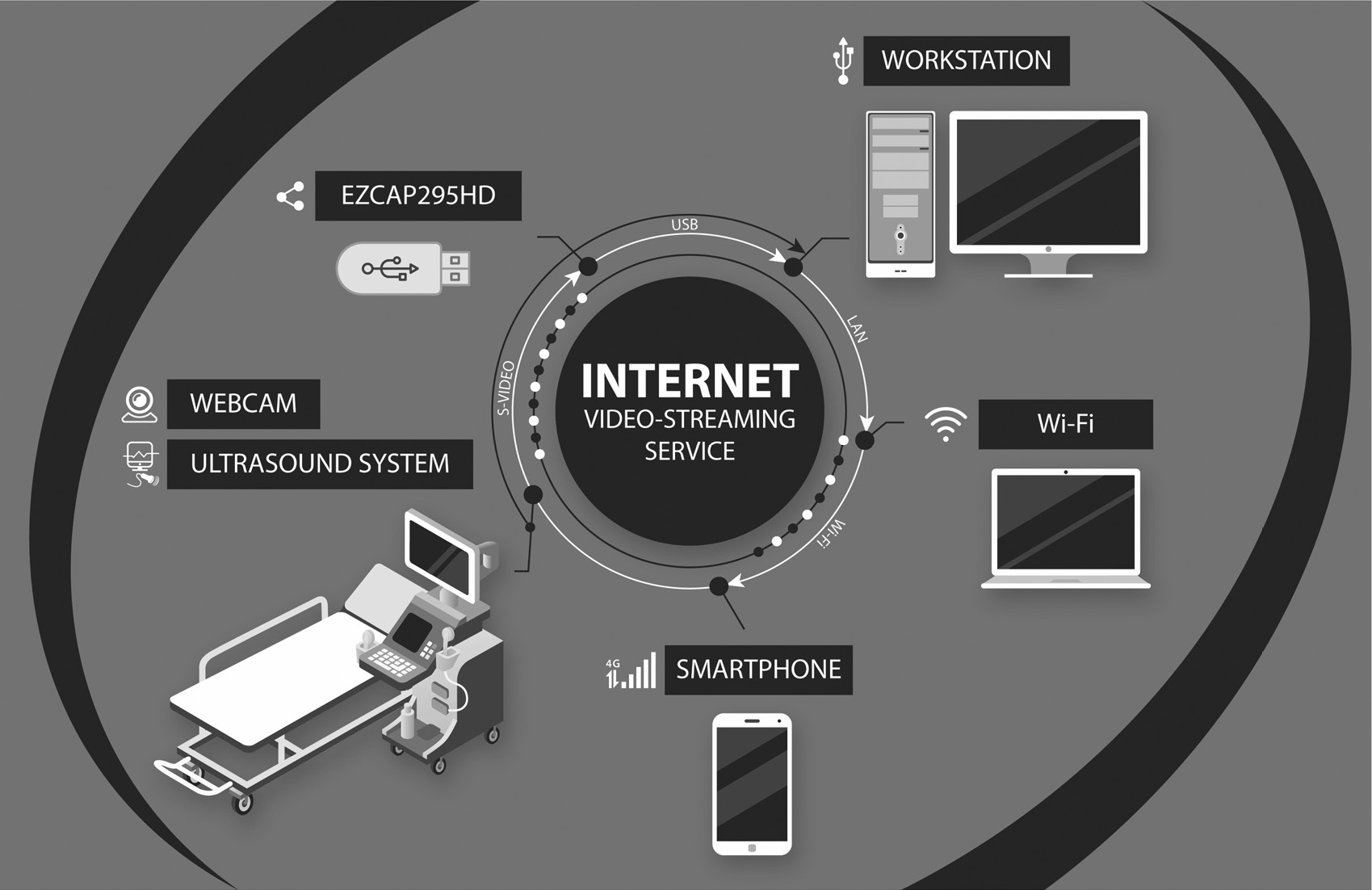Стриминговые технологии: из игровой индустрии в телеультразвуковые исследования
- Авторы: Арзамасов К.М.1, Бобровская Т.М.1, Дроговоз В.А.2
-
Учреждения:
- Научно-практический клинический центр диагностики и телемедицинских технологий
- Научно-производственное объединение «РусБИТех»
- Выпуск: Том 3, № 2 (2022)
- Страницы: 131-140
- Раздел: Технические отчеты
- URL: https://journals.rcsi.science/DD/article/view/100779
- DOI: https://doi.org/10.17816/DD100779
- ID: 100779
Цитировать
Аннотация
Обоснование. Стремительное развитие игровой индустрии привело к появлению многих технических средств и технологий с уникальными характеристиками. Одной из таких технологий, имеющих высокий потенциал к применению в медицинской диагностике, является стриминг (потоковое онлайн-вещание). Подключив ультразвуковой сканер к системе видеозахвата, возможно существенно расширить функционал диагностического устройства.
Цель ― изучить возможность применения достижений информационных технологий игровой индустрии в телемедицине на примере телеультразвуковых исследований.
Материалы и методы. В данном исследовании проводили запись ультразвукового видеоизображения при помощи системы видеозахвата, разработанной для геймеров. Видеоизображение получалось в ходе телеультразвукового исследования брахицефальных артерий в следующих режимах: серошкальный В-режим, цветовое дуплексное картирование и импульсно-допплеровский режим. В режиме реального времени проводили трансляцию исследования на видеостриминговый сервис.
Результаты. Получены оптимальные показатели видеоизображения, а также определены минимально допустимые настройки видеостриминга для адекватной дистанционной оценки врачом-экспертом по ультразвуковому исследованию. Рекомендуется использовать на автоматизированном рабочем месте видеозахвата следующие настройки: видео 1280×720, 24 кадра в секунду, кодировщик H.264, битрейт не менее 350 Кбит/с.
Заключение. Использование технических и программных средств, разработанных для стриминга видеоигр, возможно для обеспечения телеультразвуковых исследований.
Ключевые слова
Полный текст
Открыть статью на сайте журналаОб авторах
Кирилл Михайлович Арзамасов
Научно-практический клинический центр диагностики и телемедицинских технологий
Автор, ответственный за переписку.
Email: k.arzamasov@npcmr.ru
ORCID iD: 0000-0001-7786-0349
SPIN-код: 3160-8062
к.м.н.
Россия, МоскваТатьяна Михайловна Бобровская
Научно-практический клинический центр диагностики и телемедицинских технологий
Email: t.bobrovskaya@npcmr.ru
ORCID iD: 0000-0002-2746-7554
SPIN-код: 3400-8575
Россия, Москва
Виктор Анатольевич Дроговоз
Научно-производственное объединение «РусБИТех»
Email: Vdrog@mail.ru
ORCID iD: 0000-0001-9582-7147
SPIN-код: 1804-2636
к.т.н.
Россия, МоскваСписок литературы
- Щепин В.О. Оснащенность и деятельность подразделений ультразвуковой диагностики медицинских организаций Российской Федерации // Бюллетень Национального научно-исследовательского института общественного здоровья имени Н.А. Семашко. 2014. № S. С. 20–26.
- Стерликов С.А., Леонов С.А., Сон И.М., и др. Обеспеченность диагностическим оборудованием медицинских организаций, оказывающих помощь в амбулаторных условиях // Менеджер здравоохранения. 2016. № 3. С. 44–55.
- Liteplo A.S., Noble V.E., Attwood B.H. Real-time video streaming of sonographic clips using domestic internet networks and free videoconferencing software // J Ultrasound Med. 2011.Vol. 30, N 11. P. 1459–1466. doi: 10.7863/jum.2011.30.11.1459
- Jensen S.H., Duvald I., Aagaard R., et al. Remote real-time ultrasound supervision via commercially available and low-cost tele-ultrasound: a mixed methods study of the practical feasibility and users’ acceptability in an emergency department // J Digit Imaging. 2019. Vol. 32, N 5. P. 841–848. doi: 10.1007/s10278-018-0157-9
- Kim C., Cha H., Kang B.S., et al. A feasibility study of smartphone-based telesonography for evaluating cardiac dynamic function and diagnosing acute appendicitis with control of the image quality of the transmitted videos // J Digit Imaging. 2016. Vol. 29, N 3. P. 347–356. doi: 10.1007/s10278-015-9849-6
- Lomb B., Güneysu T. Decrypting HDCP-protected video streams using reconfigurable hardware // Proc 2011 Int Conf Reconfigurable Comput FPGAs. ReConFig. 2011. Р. 249–254. doi: 10.1109/RECONFIG.2011.24
- Aaron A., Li Z., Manohara M., et al. Per-title encode optimization. The Netflix Techblog, 2015. Режим доступа: https://netflixtechblog.com/per-title-encode-optimization-7e99442b62a2. Дата обращения: 15.02.2022.
- Carbone M., Ferrari V., Marconi M., et al. A tele-ultrasonographic platform to collect specialist second opinion in less specialized hospitals // Updates Surg. 2018. Vol. 70, N 3. P. 407–413. doi: 10.1007/s13304-018-0582-9
- McBeth P., Crawford I., Tiruta C., et al. Help is in your pocket: the potential accuracy of smartphone- and laptop-based remotely guided resuscitative telesonography // Telemed e-Health. 2013. Vol. 19, N 12. P. 924–930. doi: 10.1089/tmj.2013.0034
- Miyashita T., Iketani Y., Nagamine Y., Goto T. FaceTime for teaching ultrasound-guided anesthetic procedures in remote place // J Clin Monit Comput. 2014. Vol. 28, N 2. P. 211–215, doi: 10.1007/s10877-013-9514-x
- College of radiology, American. ACR-AAPM-SIIM technical standard for electronic practice of medical IMAGING. 2017. Режим доступа: https://cdn.ymaws.com/siim.org/resource/resmgr/guidelines/elec-practice-medimag-2017.pdf. Дата обращения: 15.02.2022.
Дополнительные файлы










